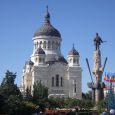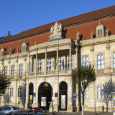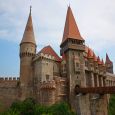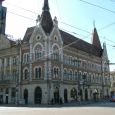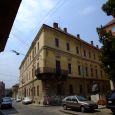Cluj-Napoca
Advertisement
By plane
The International Someşeni Airport of Cluj-Napoca is offering flights to Bucharest, Timisoara, Budapest, Vienna, Frankfurt, Munich, Dusseldorf, Stuttgart, Dortmund,Milano, Bologna, Ancona, Bergamo, Florence, Rome, Treviso, Verona , Lviv, Paris, Barcelona, Valencia, Madrid and London provided by Blue Air, TAROM, Austrian, Lufthansa, Iberia, Alitalia, Carpatair, Malev and Wizzair).
By train
As with many other Romanian cities, train is the easiest way to reach Cluj from Bucharest. There are train connections to most Romanian cities, including fast InterCity connections to Oradea, Arad, Timisoara, Brasov, Sighisoara, Ploiesti and Bucharest. Many trains to Budapest leave early in the morning.
By bus
Cluj-Napoca can be reached by bus from Bucharest, major cities in Romania, most cities in Transylvania, and a number of major cities in Europe. Search for a route online
By car
Cluj-Napoca has good road connections. European road E60 links it to Bucharest and Brasov to the south, Oradea and Budapest to the west, through Bors customs. E81 leads to Zalau and Satu Mare to the north, Brasov and Bucharest to the south. E58 links Cluj-Napoca to Dej, Bistrita, Baia Mare and Vatra Dornei.
Dormition of the Theotokos Cathedral
The Dormition of the Theotokos Cathedral is the most famous Romanian Orthodox church of Cluj-Napoca, Romania. Built in a Romanian Brâncovenesc style, a synthesis of Renaissance and Byzantine architecture, it lies on the Avram Iancu Square, together with the Cluj-Napoca National Theatre and the Avram Iancu Statue.The Cathedral is the seat of the Metropolitan of Cluj, Alba, Crişana and Maramureş. It is dedicated to the Dormition of the Theotokos .
Central Park
Central Park is a large public, urban park in the borough of Centru in Cluj-Napoca. It was founded in the 19th century and it located on the souther shore of Someşul Mic River. The Park is now home to the University of Arts and Design and to the Chemistry Faculty of the Babes-Bolyai University.
St. Michael's Church
The Church of Saint Michael is a Gothic-style Roman Catholic church in Cluj-Napoca. It is the second largest church (after the Black Church of Brasov) in Transylvania, Romania. The nave is 50 meters long and 24 meters wide, the apse is 20×10 m. The tower with its height of 76 meter (80 meter including the cross) is the highest one in Transylvania. The western portal is decorated with the three coats of arms of Sigismund as King of Hungary, as King of the Czech Kingdom and as Holy Roman Emperor.
National Museum of Transylvanian History
The National Museum of Transylvanian History is a history and archaeology museum in the city of Cluj-Napoca, Romania. It features a permanent exhibition, as well as temporary exhibitions, the "Tezaur" exhibition, and Pharmacy Historical collection—this last opened in the Hintz House, an historical building in the city's center.
Hunyad Castle
The castle is a relic of the Hunyadi dynasty. In 1409, the castle was given to John Hunyadi's father, Voyk, by Sigismund, king of Hungary, as severance. The castle was restored between 1446 and 1453 by his son John Hunyadi. It was built mainly in Gothic style, but has Renaissance architectural elements. It features tall and strong defense towers, an interior yard and a drawbridge. Built over the site of an older fortification and on a rock above the small river Zlaşti, the castle is a large and imposing building with tall and diversely colored roofs, towers and myriad windows and balconies adorned with stone carvings.
Banffy Palace
Bánffy Castle is a baroque building of the 18th century in Cluj-Napoca, designed by the German architect Johann Eberhard Blaumann. Built between 1774 and 1775 it is considered the most representative for the baroque style of Transylvania. The first owner of the palace was György Banffy 1746–1822), the governor of Transylvania.
Szeky Palace
The Szeky Palace in Cluj-Napoca is a Gothic Revival building on the shore of Someşul Mic River. It was built in 1893 for the university teacher and pharmacist Szeky by the architect Samu Pecz. It is included in the list of historical monuments of the Romanian Ministry of Culture.
Information not available


